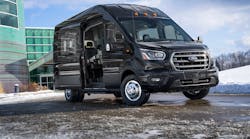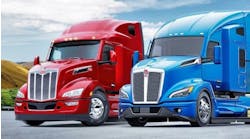What’s the mark of a truly safe vehicle? One way to tell, of course, is the crash rating. If I’m in the vehicle, though, I’d prefer not to ever find out about crumple zones or how quickly the air bags deploy. I look for the features that help me avoid danger, not soften the blow. And that’s precisely why I was without apprehension climbing into the driver’s seat of the 2020 Transit Crew Van sitting in my driveway, which features Ford Co-Pilot360, the automaker’s advanced driver assistance system (ADAS). Along with a few new ADAS additions, the crew seating and Intelligent All Wheel Drive (AWD) are new to the platform.
“We've taken the vehicle up to the same level as any passenger cars,” explained Ray Eyles, chief program engineer, Ford Transit North America, prior to my three-day test period. He said Ford’s engineering team eschewed the previous light van industry standard of “mak[ing] it cheap as you possibly can” with little emphasis on safety.
Things have changed. “It's much more important for us to make sure that we're on the leading edge of the safety technologies with the vans as well,” Eyles said. “These things are more difficult to drive, they're unfamiliar for people. The visibility in a van is not as good as in many cars.”
The Co-Pilot360 mitigates all those factors with an array of sensors and cameras. This includes: Pre-Collision Assist with Automatic Emergency Braking , which alerts the driver and can intervene when an object is too close to the front bumper; Lane Keeping Assist to notify the driver via a visual light on the dash, and slight steering wheel haptic feedback if the vehicle drifts over the line in the absence of an active turn signal; and Blind Spot Information System (BLIS), a handy sensor that illuminates an alert when a vehicle is coming alongside the back.
Pre-Collision Assist Warning and Lane Keeping Assist are standard, while the BLIS is optional. Equipped on this test vehicle, BLIS was by far the handiest helper for this neophyte delivery driver. My daily driver is a Chrysler Town & Country, but this Transit Crew has a 148-inch wheelbase, more than two feet longer. Overall this Transit was 20 feet long and nine feet high.
For my first mission, I was about to drive from my home on the fringe of the Cleveland metropolitan area’ to the tightly packed Slavic Village neighborhood. My goal was to drop off some baby-related items to a charitable organization called Another Chance of Ohio, a refitted house with rooms of home goods and clothes that allows the community to “take what you need, as long as you need what you take.”
I was hauling maybe 100 pounds in the back of the spacious van, though even with that light load the new 3.5L PFDI V6 gasoline engine didn’t provide as much “giddy-up” as I would have liked merging onto the highway. A 3.5L EcoBoost version is also available for better performance, and adds the start/stop function while idling for better fuel economy.
The actual maneuvering was far easier than anticipated with such a big vehicle that I really didn’t want to damage, and the lane checking really helped. I would argue that for the next version, the BLIS become standard. You never know when some impatient motorist is going to try and zoom past.
Ford’s navigation got me to my destination and while this Transit has Enhanced Active Park assist, I just used the rear camera to back up the narrow driveway, swung the doors open, which can extend out 253 degrees, and made the drop-off. Rain started falling and the navigation had trouble helping me find the highway, due to the onramp closure due to construction. I’m a local, so I found my way back to the highway just in time for a heavenly deluge of rain dropping down on me and my fellow drivers. “This is how I die,” I thought. Luckily, the van proved seaworthy on the new Interstate river, and probably due to the all-wheel drive, I could hardly tell how much water was rushing past as I kept a safe 30 to 35 mile-per-hour speed. The telematics report noted I only had a few harsh braking events at the start of the journey (while I was feeling the van out).
The next day I made another delivery to the Louis Stokes Veteran’s Hospital, as Ford was gracious enough to donate four boxes of face shields and masks it manufactured to combat the COVID-19 pandemic. That drive was uneventful and by then it felt like I had been driving the vehicle for years.
The only real gripe I had was that the navigation refused to put me on the turnpike during my journey to Milan, Ohio, where I was dropping the van off to my colleague, though that is merely a setting you can change. As far as drivability and safety, I believe Ford did a great balancing act and looks like the 41 years of dominance in the van space will continue.






